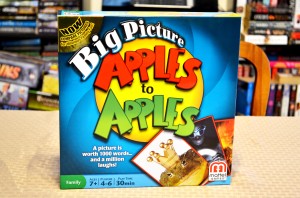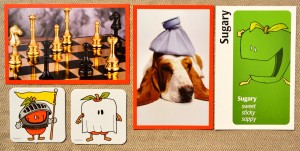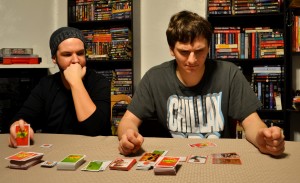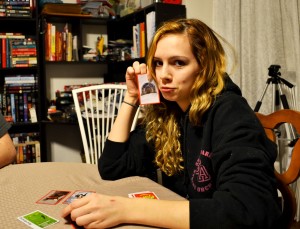I’ve said it before and I’ll say it again…”Apples to Apples” is probably one of the most popular games in our household. It’s easy to play and the kids really get a kick out of making silly combinations with the cards. Earlier today, I saw “Apples to Apples: Big Picture” sitting on the shelf at my local Wal-Mart and figured I’d give it a go. It looked similar to the “Apples to Apples: Junior Edition” we often bring out to play, but it had pictures…I admit, I was a little intrigued. I had to wonder how it compared to similar picture games I’ve played (like “Crappy Birthday“), though I’m sure the big question on your mind is, “is this version of ‘Apples to Apples’ as fun as the other editions?” Well, keep reading to find out!
Components
Red Apple Cards – There are a total of 463 red apple cards, each with a unique picture with no text that describes a person, place, thing, or event. There are seven blank cards so that players can add their own pictures to the deck.
Green Apple Cards – There are a total of 160 green apple cards, each with a word that describes a person, place, thing, or event.
Apple Tokens – These double-sided tokens are used for scoring.
Setup & Gameplay
Players will start by choosing a red and green deck, shuffling them separately, and dealing five red apple cards to each player. Players may look at their cards, as this will be their starting hand. Players then decide who will start off the game as “The Judge”.
The judge will draw a green card from the deck and read it aloud. All players, except for the judge, will play a red card that they like the most face down. It doesn’t matter if the red card a player chooses matches the green card…all that matters is whether or not the judge will choose it down the line. After all players have chosen a card and played it face down, the judge will mix them up and choose the one that they like the most. The player whose card was chosen gets an apple token and the role of the judge passes off clockwise to the next player. The cards played for that round are all discarded. Hands are refreshed and play continues until one person manages to earn five apple tokens. The person who does so, wins the game!
The above doesn’t cover all of the rules found in the manual, but should give you an idea as to how the game is played. For more information, you can view the manual here:
http://service.mattel.com/instruction_sheets/Y1925%20Instructions.pdf
The Review
The components themselves were fine, but I took issue with the recommended age limit. It can be hard to pin down a good age range, namely because kids mature at different speeds and parents have varying tolerances for what they expose their kids to. In this case, I saw maybe five cards that were borderline “what the heck”, but I didn’t feel any of it was inappropriate for the kids to see. Vinnie is the youngest of the bunch and he’ll be thirteen in a few months…there’s nothing on these cards that he hasn’t seen before at the local swimming pool. There’s no nudity, but some cards feature a little cleavage and body hair here or there. One card features an acrobat bending backward above a topless man while another features a pregnant woman revealing her bear belly while wearing construction worker attire…parents will have to decide for themselves if that would be considered appropriate. In all honesty and to be safe, I’d bump up the minimum age to say, ten or twelve plus.
Besides that, this version of “Apples to Apples” is a fun edition to the series. “Crappy Birthday” was and still is a very fun game, but the pictures tended to repeat themselves after three or four games. With 450 plus picture cards, this version will last us a while, even after a few playthroughs. While I made it sound like some of the cards were kid-inappropriate, most are well suited for younger kids. You’ve got varying pictures of animals and people doing different things, the quality of which were pretty good, I feel. As a photographer in my spare time, I can vouch that some of the cards were really well done. The green cards, while offering nothing new, still educate younger players with regard to vocabulary. There’s also a few different ways to play, if you’re willing to be creative (players submit two red cards instead of one, judge chooses two cards, etc.).
In the end, the family and I gave this version a thumbs up, though Jen (my other half) did express that she liked “Apples to Apples Junior” better. My recommendation to parents, especially the conservative ones, is to go through the red cards ahead of time and pick out the ones they feel are inappropriate before sitting down to play. For twenty bucks, I felt it to be a good investment considering how much time we spend playing “Apples to Apples” as a whole.
Final Verdict: 8/10
—




